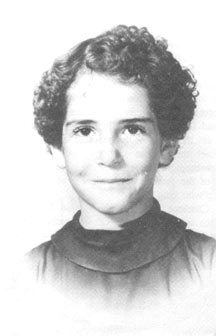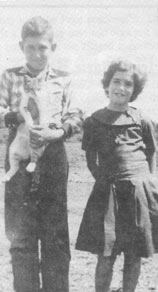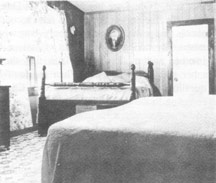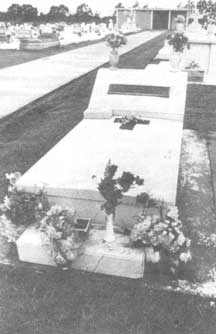Charlene Marie Richard
A Saint for Louisiana?
Compiled from book by Barbara Lenox Gutierrez
 |
Charlene Marie Richard was born January 13, 1947. After being diagnosed with acute lymphatic leukemia, she died on August 11, 1959, at the age of 12. But this little girl had a faith and devotion rarely seen in our modern world, and her life has inspired many to follow her heroic example. And because of quick answers to prayers said through her intercession, and the change in many lives for the better, people in Southwest Louisiana are asking for her beatification.
Charlene was the second of ten children born to Mr. and Mrs. Joseph Elvin Richard. "Theirs was a very religious home," Fr. Frank Bussieres, the pastor, said. "The family had a lot of faith and trust in God. It's no wonder that Charlene would seem to be so religious. She came from a family of people who were not afraid to talk about God. Her strong faith was the result of the faith of the family into which she was born."
From her earliest years, Charlene had a special devotion to the Blessed Virgin Mary. When she was only five years old, Charlene had picked up her grandmother's rosary.
"Is this yours?" she asked her grandmother. "I'd sure like to have one like that. Do you say your rosary everyday, Mom-Mom?"
The grandmother answered that yes, she said the rosary every day.
"I'd sure like to know how to say the rosary, too," the young Charlene replied.
So the grandmother sat with the five-year-old child and began to teach her to pray the rosary. By the time Charlene was seven, she could say the rosary on her own and it had become a daily devotion in her life.
When Charlene was in the fourth grade, her family moved from Church Point to the Richard community. Charlene was an avid sports enthusiast and she participated in baseball and basketball, playing on the school teams and even becoming team captain of the basketball team at Richard Elementary.
Charlene's mother remembers her daughter as being very competitive. "She always hated to lose," she said. "If they lost to a particular team, Charlene would always want to be able to play that team again so that she could have another chance to beat them."
This sense of competitiveness extended to her schoolwork, also. Charlene's older brother, John Dale, remembers that Charlene stayed up late many nights studying. Charlene's mother said that she remembers vividly how much Charlene never wanted to miss school or Mass.
One of Charlene's best friends during this time was Lucille Link. Lucille and Charlene and some of the other girls would get together and bake cookies for the basketball games. It was also during this time that Charlene acquired the nickname of "Charlie Brown" from her friends. To her family, she was known as "Sue-Sue." During the summer months Charlene and her friends would ride horses and play together just as children do everywhere.
One of the favorite happenings during the summer vacation was the summer school program at St. Edward Church in Richard. Charlene's older brother, John Dale, recalls that he and Charlene especially liked to write plays and act them out with the other children. One summer they wrote a special play for Father Frank Bussieres in which John Dale played the part of the priest and Charlene was one of the group who sang.
 |
"Charlene loved to play," said John Dale. "When we were little, I can remember that we would play church. Charlene would always want me to play the part of the priest and we would pretend that we were at Mass. The other children would join us and we would have altar boys and deacons. Children from all over would gather in our yard for these pretend Masses."
In May of 1959 Charlene was encouraged by her religion teacher, Mrs. Zula Miller (now deceased), to say the rosary every day during the month of May. Charlene was already accustomed to saying her rosary every night before she went to bed. But in honor of this special month, she decided to do something different.
Mrs. Richard said that Charlene went home and, using a small end table, erected a tiny altar in her room. On the altar she placed a picture of the Blessed Mother, a crucifix and an old bible. Each morning Charlene would go out into the yard and pick a fresh rose from the bushes growing along the house and would place it on the altar. Then she would kneel and recite her rosary.
One of the happiest events in Charlene's life was in May, 1957, just after she had made her Solemn Communion. Her grandmother had gone to special pains to make her dress a memorable one. The skirt was scalloped and the dress was trimmed with flowers. A wreath of flowers crowned her dark hair. She was ten years old.
According to Mrs. Richard, the family customarily went to Mass in Church Point on Sunday morning. This particular Sunday, however, the family decided to do something a bit different. They drove to the tiny community of Richard for Mass. Charlene was wearing her Communion dress, complete with the flower crown.
When the family arrived at the small church, said Mrs. Richard, they saw a large group of children gathered outside. Unknown to the Richards, this was the Sunday chosen for the crowning of the statue of the Blessed Mother. They got out of their car and went to join the crowd. Father Frank Bussieres was pastor of St. Edward Parish at that time. To the surprise of the entire Richard family, he approached Charlene and directed her to the front of the line of children. That day, the statue of the Blessed Mother was crowned by Charlene.
Charlene's family has never been financially wealthy. Rather, they are people who lead a life of simplicity. Their homes have always been clean and comfortable but very modest. There have never been any of the modern conveniences found in many houses, such as air conditioning, dishwashers, carpets. So when Charlene had the opportunity to visit her friend Lucille Link's new house, she came home very excited with what she had seen.
 |
"Mama, you should see what a beautiful house I visited today," Charlene said. Mrs. Richard remembers especially that Charlene was impressed with the chandelier hanging in the dining room of the new home.
"Mama, it was so beautiful," she said. "I know I'll never live in a house like that."
Then, her mother recalls, Charlene stopped, reflected awhile and said, "Oh, well, when I die, heaven will be prettier than that."
It was just a short time later that Charlene discovered a book, in the form of a picture-story much like the comic books of that time. This particular book, however, was about St. Theresa, the French Carmelite nun in the last century who is better known today as the Little Flower. Charlene took the book home with her and told her grandmother all about the beautiful story she had read.
The grandmother recalls: "Sue-Sue read the story to me. She told me that she wanted to be like St. Theresa. She asked me if she could be a saint, too."
"If I pray like St. Theresa, will it happen?" Charlene asked her grandmother.
"Yes, if you pray in the right way." she was told.
Charlene and her grandmother were very close. They shared the same room. Charlene's parents lived next door and Charlene chose to sleep with her grandmother rather than in her own home.
"Sue-Sue came here every night to sleep," said Mrs. Matte. "Sometimes she would sleep in the cot in my room and sometimes she would get in bed with me to sleep. But she always slept in my room."
There developed between the two, the child and the older woman, a deep bond of affection and love and trust. It was this grandmother who played a most vital part in shaping and encouraging the spiritual development of the young girl. Mrs Matte was ill during most of the first part of 1959, having surgery in January and again in May. She was in great pain and seemed to get relief from an ointment which was applied to the incision area.
"Many nights I can remember waking up and feeling Sue-Sue's hand rubbing the ointment on me," said Mrs. Matte. "I guess she would hear me groan in my sleep and she would wake up and put the medicine on me to help my pain. When I think about it, I can almost feel her little hands on me again," she said with tears in her eyes.
Picture
It was during the latter illness of the grandmother that the first portent of Charlene's own trials and sufferings took place. The time was late spring, near the end of the 1958-59 school term. Charlene's mother, grandmother, and John Dale, who was 14 at that time, remember the incident vividly. Charlene had been in the back yard, near the clothesline and she came running into the house to her mother, visibly shaken.
"Mama, you won't believe this," she said.
"I know you'll laugh at me, but it really did happen."
Mrs. Richard said that she could see that her daughter was pale and she knew that something had happened to frighten Charlene. She encouraged Charlene to tell her about it.
"Mama, I saw a lady, a tall lady dressed in black," Charlene told her mother. "She stopped me. I looked up and saw something shaped like a woman but I couldn't see her face. I was scared. When I asked her, 'In the name of God, what do you want?' she just sailed under the oak tree and disappeared.
John Dale said that he remembers quite clearly how frightened Charlene was. "She was so scared that she was shaking all over and my grandmother had to hold her to try to make it stop," he said.
The next day Charlene and John Dale were in the back yard emptying a tub of water when Charlene said, "Oh, I see her again." John Dale said that his memory concerning this second incident is very hazy and he only vaguely remembers it taking place. But Charlene's grandmother and mother both claim that they remember that it did happen. When the family was questioned, no one could remember Charlene referring to the incidents thereafter.
A few weeks later, Charlene became ill with what was finally diagnosed as acute lymphatic leukemia. Dr. Daniel Voorhies recalled, "I believe that Charlene was first sent to me with the possibility of rheumatic fever. I examined her, had her hospitalized for extensive tests, and discovered that she was suffering from acute lymphatic leukemia. She was released from the hospital after the tests but had to return in less than a week." Dr. Voorhies said that he remembers Charlene well. "She was a quiet type of child, unassuming, shy—an excellent patient. We were not using all the drugs then that we have today. There was very little we could do for her. Today, I'm sure that she would be sent to a special center. But at that time, there was none. She received the customary treatment of whole blood, with Demerol for pain. We tried to keep her as comfortable as possible. Sister Theresita would accompany the hospital chaplain on his daily rounds and she noticed that Charlene was a "very pious little girl."
"Charlene suffered a great deal," said Theresita. "It's the nature of the disease. The pain is awful and there is almost constant bleeding and hemorrhage. But I remember her as a cheerful patient. She never complained."
Sister said that she remembers that Charlene was especially fearful of the bone marrow tests which involved inserting a long needle through the breast bone. "I held her hand through the entire procedure," Sister said. "I suggested to her that we make it a big prayer. Charlene's prayer was that one of her brothers become a priest. She was very zealous to have a brother-priest. Charlene's prayer for a brother-priest was not answered directly. While one brother, John Dale, did enter Immaculata Seminary for a short while, he eventually became a licensed practical nurse and married. But Charlene lacks no brothers numbered among the priesthood, for it seems to be the priests in the diocese, especially in the area around where she lived and died, who have the most confidence in her, who openly express their belief in her sainthood and who encourage others to pray to Charlene for intercession with God in times of need.
Fr. Floyd Calais is one of these priests. It is probably due to him more than anyone else that devotion to this little girl has spread. Strangely enough, he never met Charlene. He first heard about her through the hospital chaplain, Fr. Joseph Brennan.
"He told me about a young girl who was very ill with leukemia," said Father Calais. "I knew that she was being treated by Dr. Dan Voorhies, who is a good friend of mine. I remember that the doctor had said that she had about six weeks left to live, but in fact she lived only about three weeks after the diagnosis.
"Father Brennan was very impressed with the little girl" said Father Calais. "He told me of how she would wait for him each day to get his suggestion of whom she was to pray for, to offer up her sufferings for during that particular day."
Father Calais remembers particularly that Father Brennan told him about another patient who was in the hospital at the same time as Charlene. A fallen-away Catholic, the man was very bitter and, although near death, refused even to let a priest enter his room.
"Father Brennan told me that he himself went to Charlene's room shortly after her death and asked for her prayers for this particular man. That night the man asked for a priest and received the sacraments. He died the next day.
"There was also a nineteen-year-old girl in the hospital at the same times as Charlene," recalled Father Calais. "From what Father Brennan told me, she was very anti-religious. One day Father Brennan told Charlene about the girl and asked her to pray for her that day. Then he went into the girl's room, told her about Charlene and told her that Charlene was offering her sufferings that day for her. I don't know what the girl's immediate reaction was, but I do know that Father Brennan told me that six months later, after Charlene's death, he received the young woman into the Church as a convert."
Dr. Voorhies went to check on Charlene at 2:30 a.m. the morning of August 11.
"She was very restless and was in considerable pain," he said. "There was evidence of blood loss. I prescribed Demerol to ease her pain. There was a private-duty nurse in the room with her when I left the room."
Dr. Voorhies recalled that he was very concerned about Charlene's condition, so much so that he returned to the hospital earlier than usual to begin his morning rounds.
"I got there before the 7:00 a.m. shift," he said. "So it must have been about 6:30. When I walked into her room, Charlene was all alone and there was evidence of extensive hemorrhage.
"I was incensed that the nurse had left a patient alone," Dr. Voorhies commented. "I thought at first that Charlene had hemorrhaged to death, but she was still alive. I called the floor nurse to come in and clean her and told the hospital staff and the family to notify me immediately if they ever saw or heard from that private-duty nurse again."
Dr. Voorhies explained that at that time there was a shortage of nurses and that private-duty nurses were sometimes hired by a patient's family when a nurse was needed to stay constantly with one patient.
 |
Approximately thirteen hours after Dr. Voorhies discovered Charlene alone and bleeding, she died. It was 7:20 p.m. on August 11, 1959. Dr. Daniel Voorhies signed the death certificate.
A Catholic by birth, Dr. Voorhies has been practising medicine for more than twenty years. He says he believes in saints. Dr. Voorhies has treated many patients. He has seen many die from incurable diseases. On his large desk, which is surprisingly bare, there is one item which stands out—a picture of Charlene Richard.
Do you believe that Charlene is a saint? he was asked.
"I know that she does have this following of people who believe that she has answered their prayers," he said.
Do you believe?
"I've got her picture on my desk," he answered. "Of all the former patients I've treated, she's the only one whose picture you'll find here."
